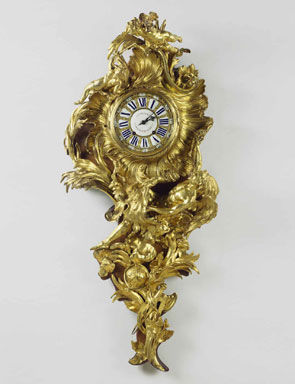"Taking Shape: Finding Sculpture in the Decorative Arts" @ the Getty Center in Los Angeles
Clock movement by Jean-Jacques Fieffe (French, about 1700-1770, maitre 1725) and case possibly after a design by Juste-Aurele Meissonier, Wall Clock (Pendule a repetition), about 1735-1740. Gilt bronze, enameled metal, wood carcass, glass. Object: H: 133.4 X 67.3 X 14.3 cm. 72.DB.89 The J. Paul Getty Museum, Los Angeles
LOS ANGELES, CA.- The disciplines of sculpture and decorative arts are often viewed in opposition to one another, the former as a fine art created for aesthetic purposes and the latter created as an applied art for functional purpose. Taking Shape: Finding Sculpture in the Decorative Arts challenges the conventional distinctions between the two by bringing together a range of “decorative” objects rarely considered within the context of sculptural practice—drawing attention to their astonishing sculptural inventiveness. On view at the Getty Center in Los Angeles, March 31 through July 5, 2009, Taking Shape brings together sculpture and furniture from the collections of Temple Newsam (England) and the Getty Museum, with a focus on 17th– and 18th– century Baroque and Rococo objects made in England, France, and Italy.
This exhibition deconstructs the prevailing assumption that decorative art is guided only by functional purpose while sculpture is infused with autonomous creativity. The objects included suggest that qualities ordinarily associated with sculpture—autonomy, creative freedom, and aesthetic intent—are often interchangeable with those traditionally linked to decorative work, such as craftsmanship, contingency, and function. While some works in the exhibition might be more readily classified as ‘sculpture’ and others as ‘decorative art’, the focus is on the interactions between them, especially their shared ground and inherent commonalities.
The objects range from sculptures intended for interior display to furnishings and are organized in three sections in the exhibition. The first section presents a range of sculptures conceived as complementary pairs, originally intended to flank altars, entrances, or hallways. The installation reveals that rather than representing the antithesis to sculpture, decoration often provided the motivation for its creation. The second section of the exhibition concentrates on the complex sculptural forms of furnishings, demonstrating that they were not simply made to be useful, but to be admired as individual objects of beauty and ingenuity. The last section of the exhibition connects the two themes explored in the preceding galleries—the decorative capacity of sculpture and the sculptural quality of furniture—by focusing on a single object from the Getty’s own collection, a gilt-wood side table attributed to Johann Paul Schor (1615-74), a sculptural tour-de-force that defies any practical use.
Co-organized by the J. Paul Getty Museum and the Henry Moore Institute, Taking Shape: Finding Sculpture in the Decorative Arts is curated by Charissa Bremer-David, curator of sculpture and decorative arts, Jeffrey Weaver, associate curator of sculpture and decorative arts, at the J. Paul Getty Museum and Martina Droth, research coordinator at the Henry Moore Institute; with assistance from curatorial consultants James Lomax, senior curator at Temple Newsam and Anthony Wells-Cole. The exhibition was on view at the Henry Moore Institute in Leeds, England, from October 2, 2008 through January 4, 2009 before coming to the Getty Center.
Surface decoration attributed to Etienne-Simon Martin (French) and Guillaume Martin (French), Pair of Decorative Bronzes, 1738-1750 (silver), 1745-1749 (bronze). Painted bronze and silver. Various dimensions. 88.DH.127 The J. Paul Getty Museum, Los Angeles

/https%3A%2F%2Fprofilepics.canalblog.com%2Fprofilepics%2F1%2F0%2F100183.jpg)




/http%3A%2F%2Fstorage.canalblog.com%2F34%2F01%2F577050%2F66379918_o.jpg)
/http%3A%2F%2Fstorage.canalblog.com%2F04%2F00%2F119589%2F66268897_p.jpg)
/http%3A%2F%2Fstorage.canalblog.com%2F05%2F37%2F119589%2F66268549_p.jpg)
/http%3A%2F%2Fstorage.canalblog.com%2F86%2F30%2F119589%2F66187962_p.jpg)